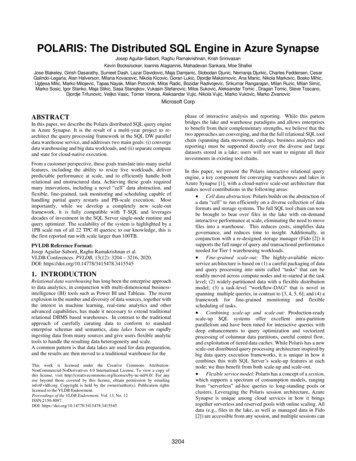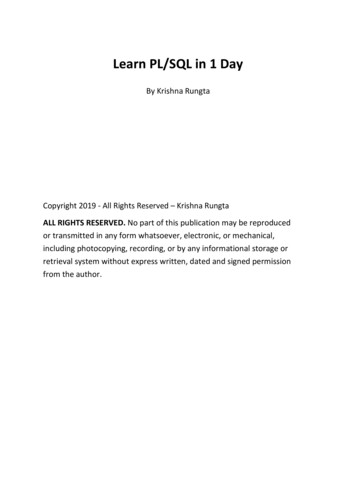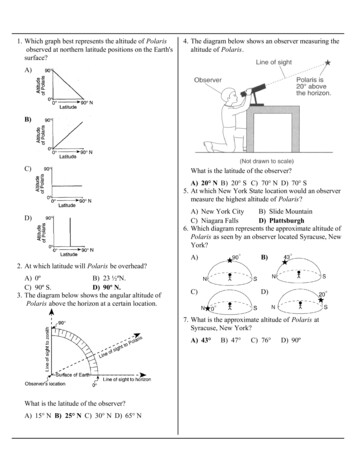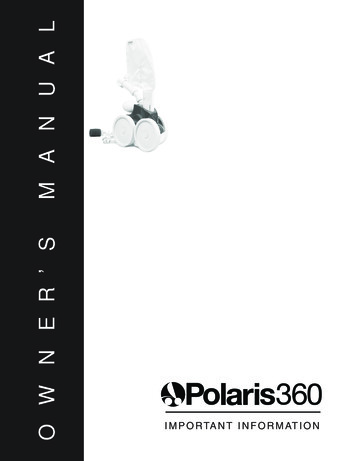
Transcription
POLARIS: The Distributed SQL Engine in Azure SynapseJosep Aguilar-Saborit, Raghu Ramakrishnan, Krish SrinivasanKevin Bocksrocker, Ioannis Alagiannis, Mahadevan Sankara, Moe ShafieiJose Blakeley, Girish Dasarathy, Sumeet Dash, Lazar Davidovic, Maja Damjanic, Slobodan Djunic, Nemanja Djurkic, Charles Feddersen, CesarGalindo-Legaria, Alan Halverson, Milana Kovacevic, Nikola Kicovic, Goran Lukic, Djordje Maksimovic, Ana Manic, Nikola Markovic, Bosko Mihic,Ugljesa Milic, Marko Milojevic, Tapas Nayak, Milan Potocnik, Milos Radic, Bozidar Radivojevic, Srikumar Rangarajan, Milan Ruzic, Milan Simic,Marko Sosic, Igor Stanko, Maja Stikic, Sasa Stanojkov, Vukasin Stefanovic, Milos Sukovic, Aleksandar Tomic , Dragan Tomic, Steve Toscano,Djordje Trifunovic, Veljko Vasic, Tomer Verona, Aleksandar Vujic, Nikola Vujic, Marko Vukovic, Marko ZivanovicMicrosoft Corpphase of interactive analysis and reporting. While this patternbridges the lake and warehouse paradigms and allows enterprisesto benefit from their complementary strengths, we believe that thetwo approaches are converging, and that the full relational SQL toolchain (spanning data movement, catalogs, business analytics andreporting) must be supported directly over the diverse and largedatasets stored in a lake; users will not want to migrate all theirinvestments in existing tool chains.ABSTRACTIn this paper, we describe the Polaris distributed SQL query enginein Azure Synapse. It is the result of a multi-year project to rearchitect the query processing framework in the SQL DW paralleldata warehouse service, and addresses two main goals: (i) convergedata warehousing and big data workloads, and (ii) separate computeand state for cloud-native execution.From a customer perspective, these goals translate into many usefulfeatures, including the ability to resize live workloads, deliverpredictable performance at scale, and to efficiently handle bothrelational and unstructured data. Achieving these goals requiredmany innovations, including a novel “cell” data abstraction, andflexible, fine-grained, task monitoring and scheduling capable ofhandling partial query restarts and PB-scale execution. Mostimportantly, while we develop a completely new scale-outframework, it is fully compatible with T-SQL and leveragesdecades of investment in the SQL Server single-node runtime andquery optimizer. The scalability of the system is highlighted by a1PB scale run of all 22 TPC-H queries; to our knowledge, this isthe first reported run with scale larger than 100TB.In this paper, we present the Polaris interactive relational queryengine, a key component for converging warehouses and lakes inAzure Synapse [1], with a cloud-native scale-out architecture thatmakes novel contributions in the following areas: Cell data abstraction: Polaris builds on the abstraction ofa data “cell” to run efficiently on a diverse collection of dataformats and storage systems. The full SQL tool chain can nowbe brought to bear over files in the lake with on-demandinteractive performance at scale, eliminating the need to movefiles into a warehouse. This reduces costs, simplifies datagovernance, and reduces time to insight. Additionally, inconjunction with a re-designed storage manager (Fido [2]) itsupports the full range of query and transactional performanceneeded for Tier 1 warehousing workloads. Fine-grained scale-out: The highly-available microservice architecture is based on (1) a careful packaging of dataand query processing into units called “tasks” that can bereadily moved across compute nodes and re-started at the tasklevel; (2) widely-partitioned data with a flexible distributionmodel; (3) a task-level “workflow-DAG” that is novel inspanning multiple queries, in contrast to [3, 4, 5, 6]; and (4) aframework for fine-grained monitoring and flexiblescheduling of tasks. Combining scale-up and scale-out: Production-readyscale-up SQL systems offer excellent intra-partitionparallelism and have been tuned for interactive queries withdeep enhancements to query optimization and vectorizedprocessing of columnar data partitions, careful control flow,and exploitation of tiered data caches. While Polaris has a newscale-out distributed query processing architecture inspired bybig data query execution frameworks, it is unique in how itcombines this with SQL Server’s scale-up features at eachnode; we thus benefit from both scale-up and scale-out. Flexible service model: Polaris has a concept of a session,which supports a spectrum of consumption models, rangingfrom “serverless” ad-hoc queries to long-standing pools orclusters. Leveraging the Polaris session architecture, AzureSynapse is unique among cloud services in how it bringstogether serverless and reserved pools with online scaling. Alldata (e.g., files in the lake, as well as managed data in Fido[2]) are accessible from any session, and multiple sessions canPVLDB Reference Format:Josep Aguilar-Saborit, Raghu Ramakrishnan et al.VLDB Conferences. PVLDB, 13(12): 3204 – 3216, 2020.DOI: https://doi.org/10.14778/3415478.34155451. INTRODUCTIONRelational data warehousing has long been the enterprise approachto data analytics, in conjunction with multi-dimensional businessintelligence (BI) tools such as Power BI and Tableau. The recentexplosion in the number and diversity of data sources, together withthe interest in machine learning, real-time analytics and otheradvanced capabilities, has made it necessary to extend traditionalrelational DBMS based warehouses. In contrast to the traditionalapproach of carefully curating data to conform to standardenterprise schemas and semantics, data lakes focus on rapidlyingesting data from many sources and give users flexible analytictools to handle the resulting data heterogeneity and scale.A common pattern is that data lakes are used for data preparation,and the results are then moved to a traditional warehouse for theThis work is licensed under the Creative Commons AttributionNonCommercial-NoDerivatives 4.0 International License. To view a copy ofthis license, visit http://creativecommons.org/licenses/by-nc-nd/4.0/. For anyuse beyond those covered by this license, obtain permission by emailinginfo@vldb.org. Copyright is held by the owner/author(s). Publication rightslicensed to the VLDB Endowment.Proceedings of the VLDB Endowment, Vol. 13, No. 12ISSN 2150-8097.DOI: https://doi.org/10.14778/3415478.34155453204
access all underlying data concurrently. Fido supportsefficient transactional updates with data versioning.utilization and concurrency. In future, we plan to buildon this global view with autonomous workloadmanagement features. See Section 6.1.1 Related Systems The most closely related cloud services are AWS Redshift [7],Athena [8], Google Big Query [9, 10], and Snowflake [11]. Ofcourse, on-premise data warehouses such as Exadata [12] andTeradata [13] and big data systems such as Hadoop [3, 4, 14, 15],Presto [16, 17] and Spark [5] target similar workloads (increasinglymigrating to the cloud) and have architectural similarities. 2. SEPARATING COMPUTE AND STATEFigure 1 shows the evolution of data warehouse architectures overthe years, illustrating how state has been coupled with compute.COMPUTEState Converging data lakes and warehouses. Polarisrepresents data using a “cell” abstraction with twodimensions: distributions (data alignment) and partitions(data pruning). Each cell is self-contained with its ownstatistics, used for both global and local QO. Thisabstraction is the key building block enabling Polaris toabstract data stores. Big Query and Snowflake support asort key (partitions) but not distribution alignment; wediscuss this further in Section 4.Service form factor. On one hand, we have reservedcapacity services such as AWS Redshift, and on the otherserverless offerings such as Athena and Big Query.Snowflake and Redshift Spectrum are somewhere in themiddle, with support for online scaling of the reservedcapacity pool size. Leveraging the Polaris sessionarchitecture, Azure Synapse is unique in supporting bothserverless and reserved pools with online scaling; thepool form factor represents the next generation of thecurrent Azure SQL DW service, which is subsumed aspart of Synapse. The same data can simultaneously beoperated on from both serverless SQL and SQL pools.Massive scale-out of state-of-the-art scale-up queryprocessor. Polaris has the benefit of building on one ofthe most sophisticated scale-up implementations in SQLServer, and the scale-out framework is designedexpressly to achieve this—tasks at each node aredelegated to SQL Server instances—by carefully refactoring SQL Server code. Global resource-aware scheduling. The fine-grainedrepresentation of tasks across all queries in the Polarisworkflow-graph is inspired by big data task graphs [3, 4,5, 6], and enables much better resource utilization andconcurrency than traditional data warehouses. Polarisadvances existing big data systems in the flexibility of itstask orchestration framework, and in maintaining aglobal view of multiple queries to do resource-awarecross-query scheduling. This improves both resourceSEPARATED FROM actXactXactDataDataDataOn-prem archStorage separation arch(a) Stateful ComputeState separation arch(b) Stateless ComputeFigure 1. Decoupling state from compute.To drive the end-to-end life cycle of a SQL statement withtransactional guarantees and top tier performance, engines maintainstate, comprised of cache, metadata, transaction logs, and data. Onthe left side of Figure 1, we see the typical shared-nothing onpremises architecture where all state is in the compute layer. Thisapproach relies on small, highly stable and homogenous clusterswith dedicated hardware for Tier-1 performance, and is expensive,hard to maintain, and cluster capacity is bounded by machine sizesbecause of the fixed topology; hence, it has scalability limits.Distributed cost-based query optimization over the datalake. Related systems such as Snowflake [11], Presto [17,18] and LLAP [14] do query optimization, but they havenot gone through the years of fine-tuning of SQL Server,whose cost-based selection of distributed execution plansgoes back to the Chrysalis project [19]. A novel aspect ofPolaris is how it carefully re-factors the optimizerframework in SQL Server and enhances it to be cellaware, in order to fully leverage the Query Optimizer(QO), which implements a rich set of execution strategiesand sophisticated estimation techniques. We discussPolaris query optimization in Section 5; this is key to theperformance reported in Section 10. Multi-layered data caching model. Hive LLAP [14]showed the value of caching and pre-fetching of columnstore data for big data workloads. Caching is especiallyimportant in cloud-native architectures that separate statefrom compute (Section 2), and Polaris similarly leveragesSQL Server buffer pools and SSD caching. Local nodescache columnar data in buffer pools, complemented bycaching of distributed data in SSD caches.The shift to the cloud moves the dial towards the right side of Figure1 and brings key architectural changes. The first step is thedecoupling of compute and storage, providing more flexibleresource scaling. Compute and storage layers can scale up anddown independently adapting to user needs; storage is abundantand cheaper than compute, and not all data needs to be accessed atall times. The user does not need compute to hold all data, and onlypays for the compute needed to query a working subset of it.Decoupling of compute and storage is not, however, the same asdecoupling compute and state. If any of the remaining state held incompute cannot be reconstructed from external services, thencompute remains stateful. In stateful architectures, state for inflight transactions is stored in the compute node and is not hardenedinto persistent storage until the transaction commits. As such, whena compute node fails, the state of non-committed transactions islost, and there is no alternative but to fail in-flight transactions.Stateful architectures often also couple metadata describing datadistributions and mappings to compute nodes, and thus, a computenode effectively owns responsibility for processing a subset of thedata and its ownership cannot be transferred without a cluster restart. In summary, resilience to compute node failure and elasticassignment of data to compute are not possible in statefularchitectures. Several cloud services and on-prem data warehousearchitectures fall into this category, including Red Shift, SQL DW,Teradata, Oracle, etc.3205
Stateless compute architectures require that compute nodes hold nostate information, i.e., all data, transactional logs and metadata needto be externalized. This allows the application to partially restartthe execution of queries in the event of compute node failures, andto adapt to online changes of the cluster topology without failingin-flight transactions. Caches need to be as close to the compute aspossible, and since they can be lazily reconstructed from persisteddata they don’t necessarily need to be decoupled from compute.Therefore, the coupling of caches and compute does not make thearchitecture stateful.The partitioning function p(r) is a user-defined function that takesas input an object r and returns the partition i in which r ispositioned. This is useful for aggressive partition pruning whenrange or equality predicates are defined over the partitioning key.(If the user does not specify p for a dataset, the partition pruningoptimization is not applicable.)Cells can be grouped physically in storage however we choose(examples of groupings are shown as dotted rectangles in Figure 2),so long as we can efficiently access Cij. Queries can selectivelyreference either cell dimension or even individual cells dependingon predicates and type of operations present in the query.Polaris is a cloud-native distributed analytics system that follows astateless architecture. In the remainder of the paper we go throughthe technical highlights of the architecture, and finally, we presentresults of running all 22 TPC-H queries at 1PB scale on Azure.A key objective for Polaris is to be a scale-out query engine forrelational data as well as heterogeneous datasets stored indistributed file systems such as HDFS. The Polaris data model istherefore designed with the following considerations in mind: 1C11C1NMCM1CMN1NUser partitions. P(r)3. THE POLARIS DATA ABSTRACTION Data CellsCellgroupingAbstraction from the data format. Polaris, as ananalytical query engine over the data lake, must be ableto query any data, relational or unstructured, whether ina transactionally updatable managed store or anunmanaged file system. Hence, we need a cleanabstraction over the underlying data type and format,capturing just what’s needed for efficiently parallelizingdata processing. A dataset in Polaris is logicallyabstracted as a collection of cells that can be arbitrarilyassigned to compute nodes to achieve parallelism. ThePolaris distributed query processing framework (DQP),operates at the cell level and is agnostic to the details ofthe data within a cell. Data extraction from a cell is theresponsibility of the (single node) query executionengine, which is primarily SQL Server, and is extensiblefor new data types.Figure 2. Polaris Data ModelFlexible Assignment of Cells to ComputeQuery processing across thousands of machines requires queryresilience to node failures. For this, the data model needs to supporta flexible allocation of cells to compute, such that upon node failureor topology change, we can re-assign cells of the lost node to theremainder of the topology. This flexible assignment of cells tocompute is ensured by maintaining metadata state (specifically, theassignment of cells to compute nodes at any given time) in adurable manner outside the compute nodes.Polaris PoolDISTRIBUTED QUERYPROCESSINGData Set Collection of data cellsPartitionsWide distribution. For scale-out processing, eachdataset must be distributed across thousands of buckets,or subsets of data objects, such that they can be processedin parallel across nodes. In Polaris, this can be expressedas the requirement that a dataset must be uniformlydistributed across a large number of cells.Hash Distributions3.1 Data CellsSTORE ABSTRACTIONAs shown in Figure 2, a collection (e.g., table) of data objects (e.g.,rows) in Polaris can be logically abstracted as a collection of cellsCij containing all objects r such that p(r) i and h(r) j.(DATA CELLS)ADLSThe hash-distribution h(r) is a system-defined function applied to(a user-defined composite key c of) r that returns the hash bucketnumber, or distribution, that r belongs to. The hash-distribution his used to map cells to compute nodes, and the system chooses h tohash datasets across a large number of buckets so that cells (andthus, computation) can be distributed across as many computenodes as needed. Further, computationally expensive operationssuch as joins and vector aggregation can be performed at the celllevel without incurring data movement if either the join keys orgrouping keys are aligned on the hash-distribution key.FidoU-ParquetAnalytical StoresSocratesCosmos DBTransactional StoresFigure 3. Store Abstraction via Data CellsStorage AbstractionPolaris abstracts distributed query processing from the underlyingstore via data cells. As shown in Figure 3, any dataset can bemapped to a collection of cells, which allows Polaris to dodistributed query processing over data in diverse formats, and inany underlying store, as long as efficient access to individual cellsis provided by the storage server. As such, Polaris can perform3206
highly scalable distributed query processing over analytical storessuch as ADLS [20], Fido [2], and Delta [21], as well astransactional stores such as Socrates [22] and Cosmos DB [23]. Ofcourse, when data is stored in columnar formats tailored forvectorized processing, this further improves relational queryperformance.physical distributed plans in the search space, the DQO usesrequired distribution properties on operators to discard alternatives.The list of required properties for each relational algebra operationis listed in the appendix of this paper.Distribution Properties as “Interesting Properties”In this paper, we mostly focus on relational queries (with theexception of Section 10.4). Data objects are assumed to haveattributes required by relational operators to which they are input.That said, the generality of the data abstraction underlying Polaris’squery processing means that we can handle datasets represented indiverse formats and stored in different repositories. For example,Polaris can run directly over data in HDFS and in managedtransactional stores. Further, different objects in a dataset coulddiffer in the attributes attached to them, and objects could haveadditional uninterpreted attributes.System R [24] introduced the concept of interesting properties,namely physical properties (e.g., sort order) such that the best planfor producing (intermediate) tables with each interesting propertyis saved during the enumeration of the search space. Thus, thecheapest plan for producing an intermediate table in sorted order bythe first column would be saved even if there is a cheaper plan toproduce the same table unsorted or in a different sort order.Similarly, in the distributed search space, the Polaris DQO uses therequired distribution properties of relational algebra operators asinteresting properties. When enumerating the physical planalternatives bottom-up, the best plan for each property and the bestplan overall based on cost are kept.4. MAPPING CELLS TO COMPUTE4.2 Data Move EnforcersA Note on QueriesPolaris provides physical operators called data move enforcers thatcan read data from a source dataset and produce a target datasetwith different distribution properties:A fundamental aspect in distributed execution is how we map cells(of source datasets as well as intermediate results) to computenodes for various operations involved in the execution of a query.As noted above, we map cells to nodes using the hash-distributionh. We now discuss this in more detail. Hash operator, Hd. Re-distributes every object (in everycell of the dataset) by hashing on column d. The numberof cells in the output dataset can differ from the input.𝐻𝑑 (𝑃[𝑐] ) 𝑃 [𝑑]𝐻𝑑 (𝑃1 ) 𝑃 [𝑑]𝐻𝑑 (𝑃 ) 𝑃 [𝑑]Broadcast operator, B. Maps the input dataset to asingle cell and replicates it across multiple locations.𝐵(𝑃 [𝑐] ) 𝑃1𝐵(𝑃 ) 𝑃14.1 Distribution PropertiesAs discussed above, data objects (e.g., tuples or rows) in a cell arehash aligned, i.e., if c is the composite key, all objects that hash tothe same cell have the same hash value or distribution h(c).Further, if two objects hash to different distribution values, theymust differ on the composite key c. As degenerate cases, objectsmay be distributed round-robin or mapped to a single cell. Weintroduce the following notation for how objects in a dataset arehashed (or not) across cells:1.2.3. ℎ[𝑐]: Objects in a dataset P are mapped to cells using ahash-distribution on column c. Also denoted as: 𝑃 [𝑐] .All objects in the dataset are hashed to the same value,i.e., there is a single hash-bucket: 𝑃1Objects in dataset P are not hash-distributed acrosscells; this situation arises sometimes for intermediateresults. Also denoted as: 𝑃 [a]PP[a]P𝑃𝑄: {𝑃1 } [a]Pa bQ1Hb (Q)a bB (P)PQ1PQP[a]B (Q)Q[a]1PQa bB (P)[c]P[c]QQ1a ba bB (Q)[a]QP[a]PP[a][c][a]PQ[b]a bQ[c]B (P)[c]PHb (Q)[a]Q[c]QPP1B (P)PWe refer to such correctness criteria on inputs as requireddistribution properties. During the enumeration of the alternative[c]a ba b[c][a]{𝑄1 }}1a ba bThe input distribution properties of a relational operator are used toguarantee functional correctness when enumerating the physicalexecution alternatives across multiple compute nodes. For instance,an inner join requires both of its inputs to be hash aligned on thejoin column, or one input to be mapped to a single hash-bucket, inorder to return the correct results while operating only on input cellsavailable locally at each node:𝑄 [𝑏] }[b]QDistribution Properties as Correctness Filters{{𝑃[𝑎]Qa ba bThe above distribution properties are used by the PolarisDistributed Query Optimizer (DQO) for two fundamentalpurposes: (1) to guarantee functional correctness of parallelexecution of operations such as joins and vector aggregations, and(2) they are used as interesting properties by the DQO whileenumerating physical distributed alternatives in the search space. 𝑎 𝑏a bP[c]QQ[c]Q1B (Q)[a]Q[c]Q[b]Hb (Q)Q[c]Figure 4. Enumeration of the search space for inner join3207
Task generation in the DQPCells to Tasks mappingMEMOCells (P)[a] a bTi QPPi[b]QiCells (Q)User partitions (M)[a]PiT1P1[b]QiT2Q1P2TNPNQ2QNHash Distributions(N)NPa bQꓴP[a]ia bCells (P)TaskDistributedplan[b]QiTi [a] a bPiCells (Q)User partitions (M)Logicalexpression[b]Qii 1[a]PiHash Distributions(N)[b]QiFigure 5. Execution ModelAs an example, Figure 4 shows the enumeration of the alternativedistributed physical execution plans for an inner join, 𝑃 𝑎 𝑏 𝑄where P and Q are (say, files in a data lake or tables in a manageddistributed relational store) hashed on a and c respectively (𝑃 [𝑎] and𝑄 [𝑐] ). The enumeration of physical alternatives starts with thescans of P and Q, shown in the bottom-most part of the figure. Q ishash distributed on column c, hence, 𝑄 [𝑐] is the first alternativegenerated. Replication and hash distribution on b are interestingproperties pushed top-down, leading to the enumeration of subplans 𝑄1 and 𝑄 [𝑐] respectively. P is hash distributed on column a,generating 𝑃 [𝑎] as the first alternative. Replication and hashdistribution on a are also interesting properties pushed top-down.Since we already satisfy hash distribution on a via 𝑃 [𝑎] , we onlyneed to produce 𝑃1 . The plan node in the top half of Figure 4 showsthe enumeration of plans for the join operation; this is a permutationof the alternatives produced by its children at the bottom of thefigure. During the enumeration, correctness filters are applied,thereby eliminating 𝑃 [𝑎] 𝑎 𝑏 𝑄 [𝑐] from the search space, sinceit does not satisfy any of the distribution properties required by aninner join. For the remaining alternatives, only the best plan foreach interesting property is kept:5.1 Polaris TasksA key challenge in Polaris was how to essentially re-architectdistributed query processing while leveraging as much of existingSQL Server capabilities as possible and ensuring that the resultingsystem was a faithful implementation of all user-visible semantics.To this end, all incoming queries in Polaris are compiled in twophases. The first phase of the compilation stage leverages SQLServer Cascades QO to generate the logical search space, orMEMO [25, 26]. The MEMO contains all logical equivalentalternative plans to execute the query. A second phase performsdistributed cost-based QO to enumerate all physical distributedimplementations of these logical plans and picks one with the leastestimated cost. The outcome is a good distributed query plan thattakes data movement cost into account, as explained in [19].When enumerating the physical space during the second phase ofthe QO process, a query plan in the MEMO is seen as a directedacyclic graph (DAG) of physical operators, each corresponding toan algebraic sub-expression E in the query. For simplicity, we useE to denote both the expression and its instantiation as an operatorin the MEMO. Operator E has a degree of partitioned parallelism Nthat defines the number of instances of E that run in parallel, eachon a partition of the input. We denote the distributed execution ofthE as 𝑁𝑖 1 𝐸𝑖 , where 𝐸𝑖 represents the execution of E over the ihash-distribution of its inputs, and N is the degree of parallelism.𝑃 [𝑎] 𝑄 [𝑏] : 𝑃 [𝑎] 𝑎 𝑏 𝑄 [𝑏]𝑃1 : 𝑃1 𝑎 𝑏 𝑄 [𝑐]𝑄1 : 𝑃 [𝑎] 𝑎 𝑏 𝑄1We illustrate the notation by means of an example. Figure 5 depictsan expression that consists of a hash aligned join between two inputrelations, P and Q. As shown on the left, the cell representation ofuser files over the lake is captured during MEMO generation bySQL Server—the first stage of QO pulls metadata from externalservices such as remote meta-stores that contain information on thecollection of files/tables, partitions and distributions.Finally, the best distributed query plan will be chosen based on thecheapest of the three options. Data move enforcers are expensiveoperators due to the cost of data re-distribution; hence, the cheapestplan is the one that minimizes data movement, as explained in [19].5. FROM QUERIES TO TASK DAGSA fundamentally new aspect of Polaris is its fine-grainedrepresentation and tracking of query execution. In this section, wedescribe how a query is compiled and optimized into an executableDAG of tasks that correspond to units of distributed execution.For this example, the input data cells are N-way hash-distributedsuch that the parallel distributed query plan is represented throughthe union of the join operation on each hash-distribution pair; (incontrast to the example of the previous section) P and Q are alreadyhash-aligned on the join column, satisfying the required3208
distribution properties of the join operator. The same notation canbe extended to represent more complex relational expressions anddistribution variations, but we omit the details.cells are persisted in local storage before they can be processed bythe consumer task.Tasks in the DAG without precedence constraints can execute inparallel, thereby achieving independent parallelism betweendifferent tasks of a query. Figure 6 expands on the example inFigure 4 with an additional join. The left hand side of the figureillustrates the physical distributed query plan that has two moveenforcers such that the join between the three relations are hashaligned into a final task, resulting into a query DAG with a total ofthree tasks.Next, we introduce the notion of a task Ti as the physical executionof an operator E on the ith hash-distribution of its inputs. Tasks areinstantiated templates of (the code executing) expression E that runin parallel across N hash-distributions of the inputs, as illustrated inFigure 5 with blue triangles. A task has three components: Inputs. Collections of cells for each input’s data partition.These cells can be stored either in highly availableremote storage, or in temporary local disks.Task template. Code to execute on the compute nodes,representing the operator expression E.Output. Output dataset represented as a collection of cellsproduced by the task. The output of a task is either anintermediate result for another task to consume or thefinal results to return to the user, and is distributed acrossseveral nodes corresponding to the consuming task’sdegree of parallelism.5.3 SQL Server Scale-up for Task ExecutionThe example in Figure 5 also illustrates an additional optimizationcarried out in the second phase of cost-based distributed queryoptimization. Observe how vertexes in the MEMO correspondingto two join operators have been combined into a single vertex thatcarries out both joins—this is because all three input datasets (P, Q,and R) are hash aligned on the same column by the preceding moveenforcer operations. Thus, in general, the template for a task caninclude code for an algebra expression involving multipleoperators.5.2 The Query Task DAGWhile we could perform the three-way join in this example in twosequential tasks, we intentionally seek to make tasks be maximalunits of work. This allows us to more effectively leverage thesophisticated scale-up columnar query processor in SQL Server. Ateach compute node, the task template of the algebraic expression Ecorresponding to the task is encoded back into T-SQL and executednatively in SQL Server. In this approach, the blocking nature of theboundaries o
decades of investment in the SQL Server single-node runtime and query optimizer. The scalability of the system is highlighted by a 1PB scale run of all 22 TPC-H queries; to our knowledge, this is the first reported run with scale larger than 100TB. PVLDB Reference Format: Josep Aguilar-Saborit, Raghu Ramakrishnan et al. VLDB Conferences.











